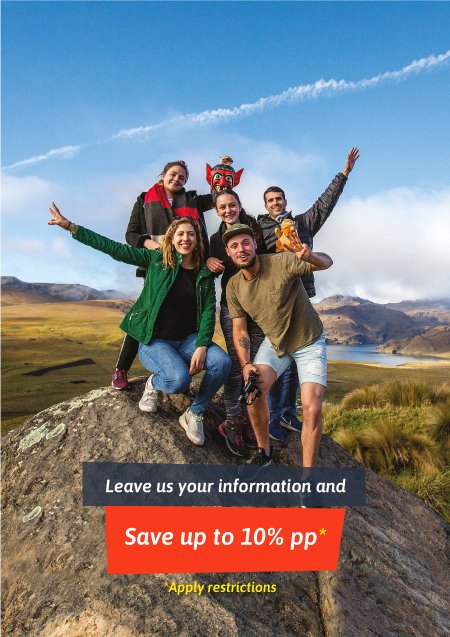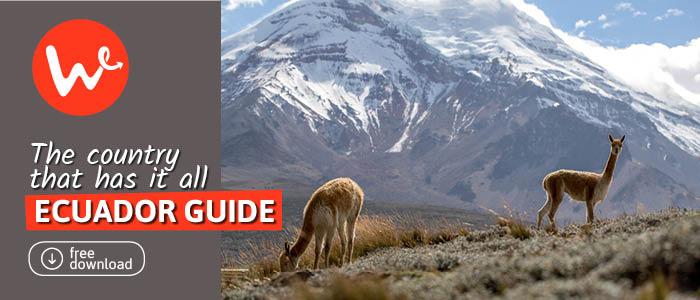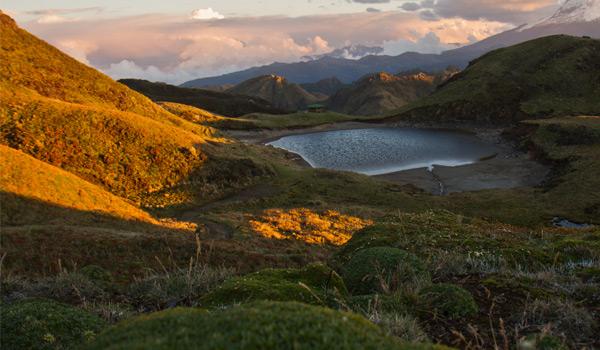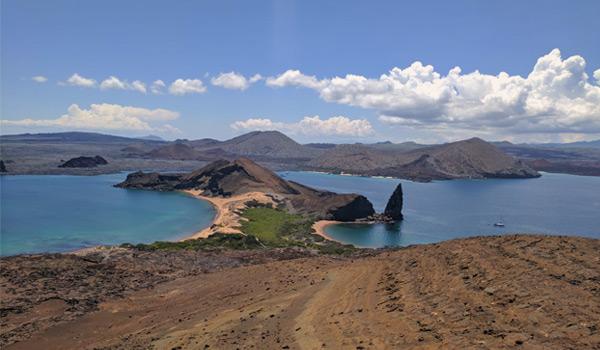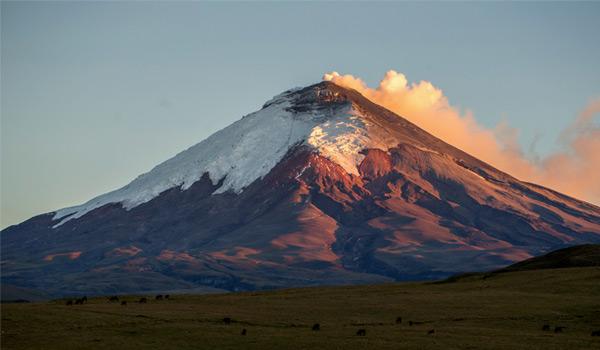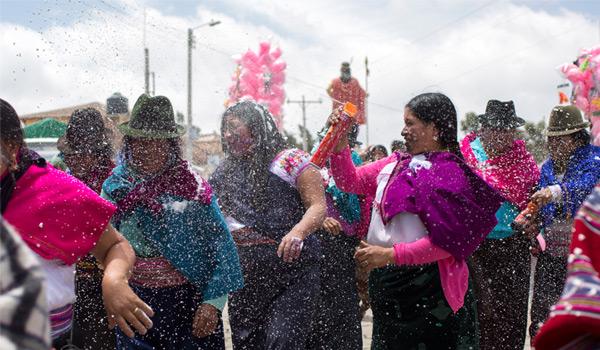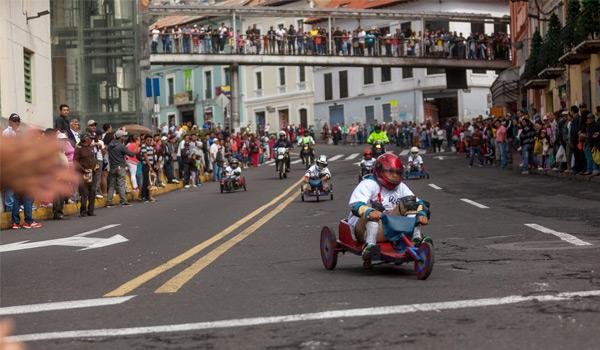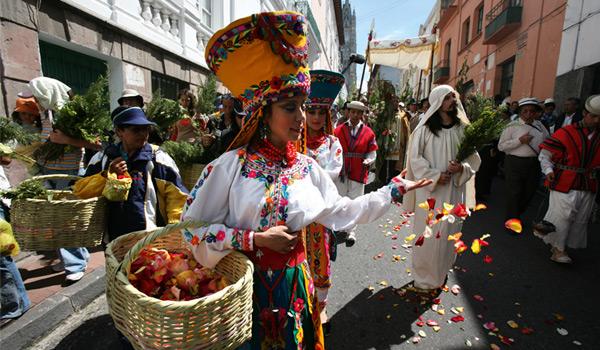Ecuador Guide
A country in the middle of the world
The Country That Has It All
The little country in the middle of the world has more things to do, see and discover than almost anywhere else on the planet.
In just a week you can… climb an active volcano and explore a mega-diverse jungle, meet incredible people from indigenous cultures and taste exotic flavours, discover a rich history in cities and the countryside and kick back on beautiful Ecuador beaches.
It’s a whole world – and an extraordinary adventure – in one, accessible country.
The Wanderbus connects the dots, bringing the disparate destinations together into one coherent route, with the most spectacular experiences along the way.
Ecuador Facts
At a glance
Size: 283,560 km² (slightly larger than the UK or Colorado State)
Population: 16.3 million
Language: Spanish and Quichua
Capital: Quito
Currency: US Dollar ($)
Ecuador backpacking budget: expect to spend a minimum of US$30/day for food and accommodation, rising to a minimum of US$60 with activities factored in.
Time in Ecuador:
- Ecuador mainland: GMT/UTC -5
- Galapagos: GMT/UTC -6
Weird fact: You could cross the whole country (either north-south or east-west) in about 10 hours flat – but with so many amazing things to see and do in Ecuador we don’t advise it!
Ecuador Geography Facts
Regions
Ecuador is divided into four distinct regions: 1) the highlands, 2) the rainforest, 3) the coast and 4) the Galapagos, creating some very cool geography:
- Ecuador is located right on latitude zero – thus its name
- Mount Chimborazo is the closest point on the Earth to the Sun
- The largest, yet least-populated, region is the Amazon
- Beautiful lakes, one of the highest active volcanoes in the world, the most biodiverse cloud and rainforests on the planet and stunning rivers linked to the Amazon
- Dozens of amazing Pacific Coast beaches
Natural Wonders
- Ecuador’s cloud forests are probably the richest diversity hotspot on Earth, home to 15-17% of the planet’s plant species, and almost 20% of its birds.
- Bears, jaguars, tiny tamarin monkeys, pumas, ocelots, anteaters, sloths, armadillos, anacondas, alligators, giant river otters and ocelots are among Ecuador’s most exotic residents.
- With more than 1,500 species of birds (700 more species than Australia) Ecuador is a bird-watcher’s paradise.
- Charles Darwin was inspired to form his theory of evolution by his visit to the Galapagos Islands and the dozens of strange creatures that exist here and nowhere else in the world, like the Galapagos penguin and the marine iguana.
- The seas of the Galapagos hold more wildlife wonders still, from tropical fish, giant turtles, manta rays and hammerhead sharks.
Getting High
There’s not much you can do to prepare for the high altitude in Ecuador. Take your time to adjust to it, ensuring to drink lots of water, avoid alcohol and cigarettes, and not attempt strenuous physical activities until your body has acclimatised.
Ecuador Weather
Ecuador’s wildly diverse geography means that separate climates and seasons are at play within each region, but really, it’s a year-round destination.
Best times to visit
Quito and Andes: June-September
Southern Coast: December-May
Northern Coast: year-round
Amazon: June-September Galapagos: November-May
Ecuador National Parks
Almost 20% of Ecuador is covered in National Parks. Here are our top three:
The Inca Trail In Ecuador
The Inca Trail in Ecuador is a system of roads built in the 15th century that connected Quito all the way to Talca in central Chile. Remains of these roads can still be seen today, and are popular hiking routes. In Ecuador the segment that is most well preserved connects a village named Achupallas to the remains of Ingapirca, one of the best preserved Inca Ruins in the former north of the Incan empire. This route crosses some of the most beautiful areas of the Andean mountains, including lagoons, ancient tambos where messengers took refuge, and a mountain pass at 4200 meters above sea level, making it one of the highest points of the Royal Road in the Incan Empire.
Hiking the Inca Trail in Ecuador
Hiking the Inca Trail usually takes around 3 days, walking a steady 5 to 6 hours a day. The route from Achupallas to Ingapirca is around 45km but at an altitude of over 3000 meters, you won’t be walking as fast as you usually would.
- Day 1: Achupallas to Cuchicorral
- Day 2: Cuchicorral to Paredones
- Day 3: Paredones to Ingapirca
Ecuador Food
With a geography and climate as diverse as Ecuador’s, it’s little wonder that there’s a great deal of variety in the country’s cuisine.

Hornado
Slow-roasted hog roast, best served with llapingacho potato patties
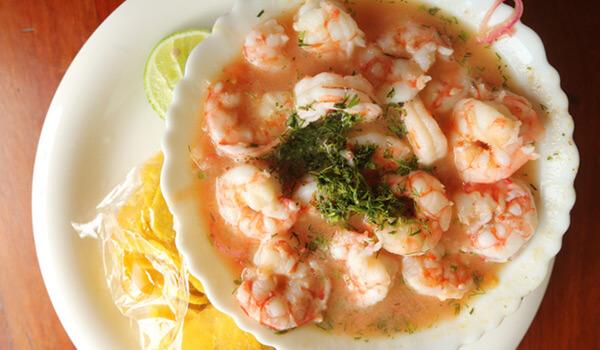
Ceviche de camarón
Delicious with shrimp, but also fish and clams, and vegetarian with chochos (lupin)

Locro de papa
A hearty potato and cheese soup from the Andes
Top Festivities
The mixture of Catholic and indigenous cultures and Latino spirit makes for a great party!
- Carnival (February)
- Semana Santa (March/April)
- Corpus Christi (June)
- Verano de las Artes Quito (August)
- Fiestas de Quito (early December)
- New Year’s Eve (December)
How To Get To Ecuador
Fly into Quito or Guayaquil international airports:
- Daily connections with Miami, New York, Atlanta, Houston, Panama, Bogotá, Lima, Mexico City, Madrid, Amsterdam…
Buses from Peru (south and also east in the Amazon) and Colombia (north)
Passports & Immigration
- Tourists are issued with a 90-day visa on arrival. Most nationalities do not need to apply for a visa before arrival.
- Those wishing to continue travelling in Ecuador past the 90-day mark can apply for a visa extension.
- Your passport needs to have at least six months left before its expiration date.
- Immigration requires you to have a departure ticket on arrival. Your airline might ask you to present it at check in.
Buses in Ecuador
Buses around cities and across the country are cheap (from 25 cents per journey). However, petty crime is prevalent and care must be taken. Timetables can be unreliable and the state of the vehicles variable.
Is Ecuador Safe?
The great majority of Ecuador has been ruled safe for travel by the UK Foreign Office, and the US State Department rates it Level 1: Exercise Normal Precautions.
You should exercise caution when travelling in crowded places; use a money belt; avoid certain neighbourhoods and parks after dark; take licensed taxis (or use a cab hailing app like Uber or Cabify); photocopy your passport to have with you; be suspicious of people ‘trying to help you’ (there is a scam where visitors are smeared with mustard (or worse) and approached by a kind Samaritan whose accomplice will divest you of your wallet/bag…); wear your backpack on the front; take local advice.
Health and vaccinations
There is a small risk of yellow fever and dengue in some parts of the country. Check with your doctor if you need these or other vaccinations. Anti-malaria medicine can be taken for visits to the Amazon, but are not essential for short visits. Precautions such as wearing long-sleeved shirts and trousers, and using mosquito repellent and nets, are, however.
How much time do you need?
The beauty of Ecuador is that it’s a small country with tonnes to do and see! Within less than one week in Ecuador you could climb an active volcano, plunge through the Amazon and swim in the Pacific Ocean. For a more in depth exploration, take three weeks or more to discover the hidden jewels of this diverse South American destination.
